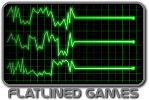Out of print
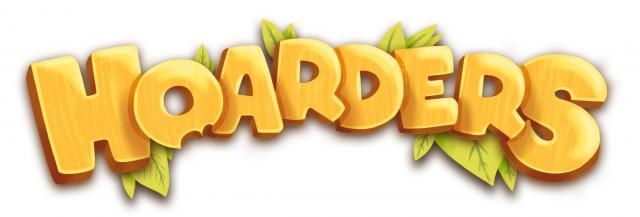
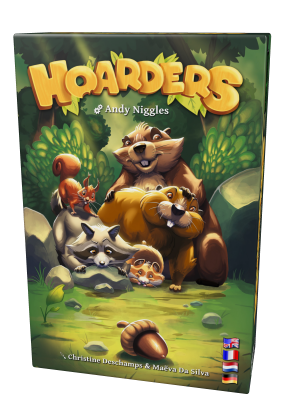
Contents :
55 nut cards
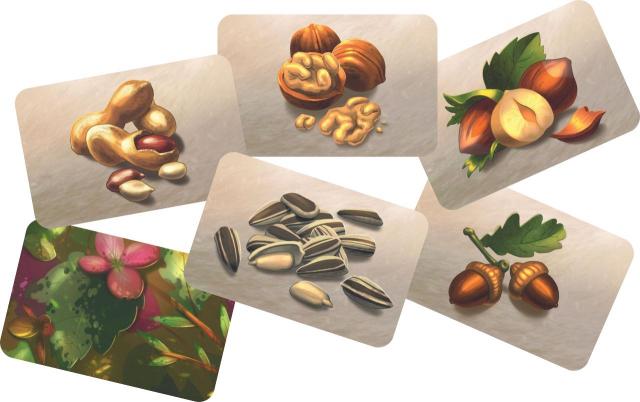
30 Critter cards
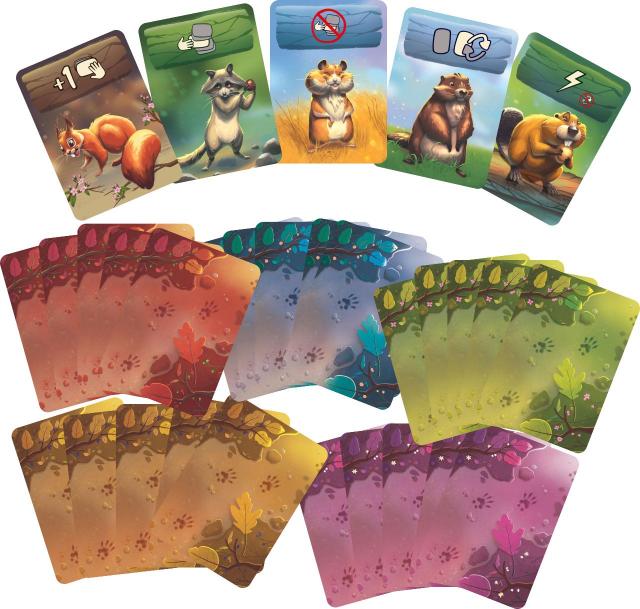
One first player token
Be the king of the forest!
Winter is coming... And the forest creatures are busy gathering nuts and hoarding food in preparation for the cold season.
Your goal is to be the first to hoard 5 nuts of the same kind before anyone else.
Hoarders is a very simple and fast-paced game for the whole family.
Each turn, you select two critters to use. Each players use one critter in turn until all critters have been used.
Critters allow you to gather nuts, to steal nuts from other player's hoards, and of course to trick your opponents.
The first to collect 5 identical nuts wins!
Game Rules
The following links leads to the pdf version of the rulesbook. You will need Adobe Acrobat or a compatible reader to view it.
Click here to download the game rules.
Videos
Marco Arnaudo :

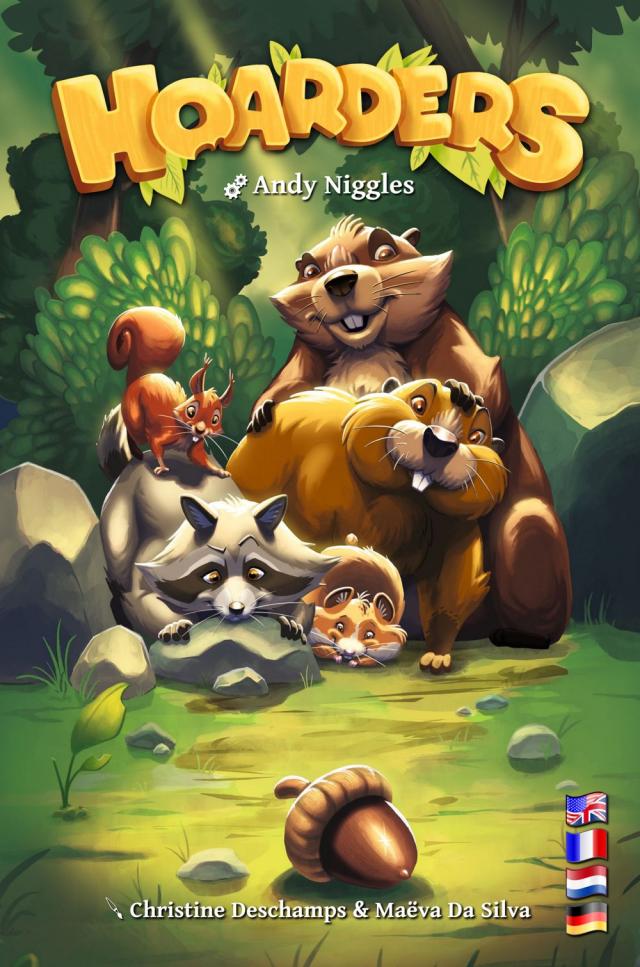
OTTER NONSENSE LIMITED PREVIEW
Current status : SOLD OUT.
Otter Nonsense is a new card game by Eric Hanuise for 2-6 players, with a duration of 15 minutes.
A card game with otters , that's otter nonsense! Play the mischievous buggers to block the next player so he will have to give yuou points! First player to 7 points wins the game.
In Otter Nonsense, players must during their turn place a card from their hand on one of the three stacks in the center of the table. They must follow the stacks direction, values up or down. If the player cannot play, he must give points to the previous player, who blocked him. Players get bonus points for emptying their whole hand, and the first to reach 7 points wins the game.
Otter Nonsense is very simple and quick to play, and has been very well received in our playtests sessions with all kind of players. Oh, and the cartoon otters art from Elisabeth Hanchir is otter-ly gorgeous!
Components : 55 poker-sized cards, 1 rulesbook (FrNlEnDe), 1 tuckbox.
CLICK HERE TO DOWNLOAD THE OTTER NONSENSE RULES.
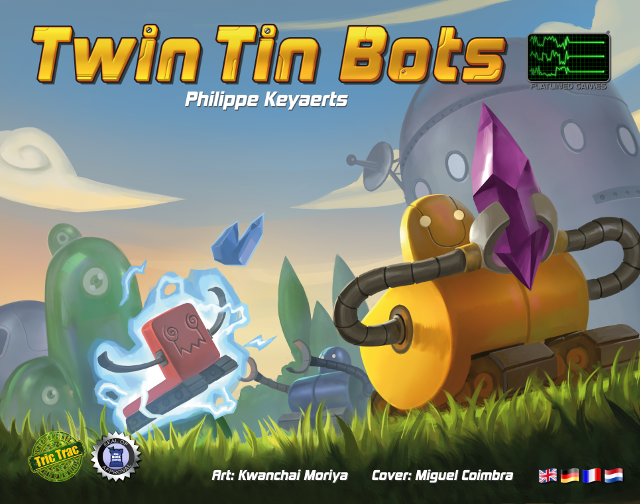
In Twin Tin Bots each player programs two robots to harvest crystals.
You use simple orders (forward, turn, harvest, unload, ...) but there are two robots to control, and only one order can be changed each turn! The other player's robots are going after the same crystals, and might push your robots or even rob crystals from them.
Twin Tin Bots is the latest game from Philippe Keyaerts, the creator of Small World, Olympos, Evo and Vinci.
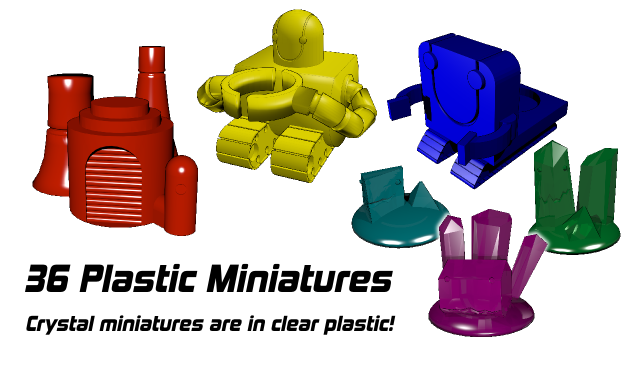

![]()
In Twin Tin Bots, you program two robots to harvest crystals and bring them into your base.
On the first turn of the game, you can play an order tile on one of each of your robots' program, and then execute it. On subsequent turns however you may only make one change to the programming.
On each turn, you can make a single program change, and then you must always run the program of both your robots, in sequence from left to right.
Even though it only allows one action per turn this clever system makes it possible to build a complex program over time. Each robot has 3 program slots available.

Your allowed programming actions are as follow :

- Place a new order tile on a program slot. If the slot was not empty, the previous order tile goes back to your hand.
- Swap the contents of two slots from the same robot. You can swap a filled and an empty slot. You cannot however swap slots from two different robots.
- Remove an order tile from a slot. The order tile goes back to your hand.
- Remove all order tiles from either robot's slots. The order tiles go back to your hand. This is useful in desperate situations, to just 'shut down' the robot.
- Make no change to the current programming of either robot
Please note that only one of the two robots' programs can be changed each turn. The other robot's program remains unchanged!
Each player has the same set of order tiles to program his robots :
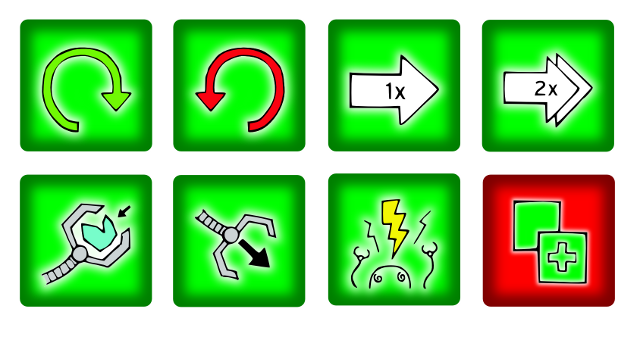
- Turn Right/Left : The robot turns 60°, facing the next hex side.
- Move forward : The robot moves in the hex in front of him, possibly pushing a crystal or robot.
- Move Twice : This is the same as two consecutive move forward orders.
- Load : The robot loads a crystal in front of him from the board.
- Unload : The robot unloads a crystal he's transporting in front of him : on the ground, in a base, or on another robot.
- Zap! : The robot sends an energy zap in front of him. The spark of energy allows him to hack another robot's program. A well timed zap! can lay ruin to the best laid plans.
- And a special order tile that once in the game allows making a change on each robot's programming instead of only one.
Remember, robots run their program every turn, no matter what! You can only make small changes along the way as they're rolling around on the crystal mine field.
Each time a crystal is unloaded in a base, a new crystal is put in play at the center of the arena. After all crystals have been put into play, the player who brought the most valuable crystals to his base wins.
Here is a video explanation of the game play :
gameplay explanation videos
Here is a video review by none other that the Dice Tower's very own Tom Vasel ! :
Here is a video review by Lance Myxter (aka UndeadViking) based on the prototype version during our Kickstarter campaign which covers the gameplay aspect and where he explains why he really loved Twin Tin Bots!
Here is a video review based on the prototype version during our Kickstarter campaign by none other that the Dice Tower's very own Tom Vasel ! :
You will only need a few turns to grasp Twin Tin Bots, and it is simple enough that children from 10 and up can play it. The game plays in under 60 minutes, even with 6 players. The player turns are very simple so game rounds are short and there is no downtime.
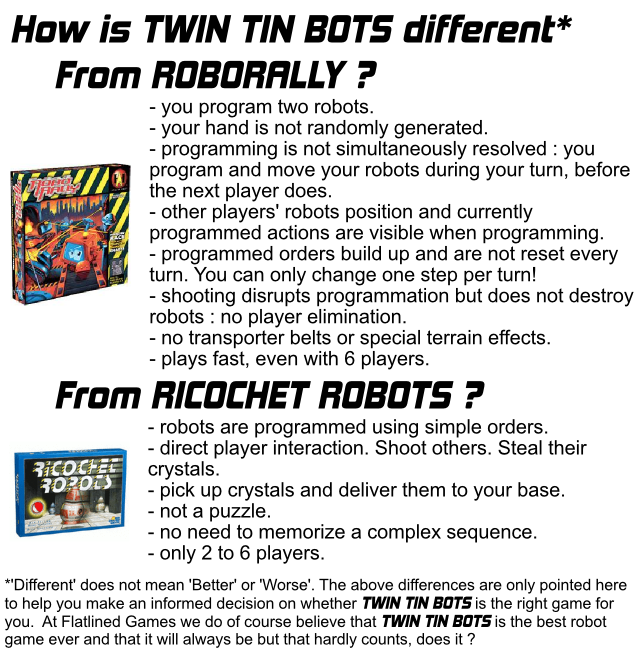
![]()
Philippe Keyaerts is a Belgian board games designer, famous worldwide for his previous titles : Small World, Evo , Vinci , and Olympos.
When not creating games, he teaches remedial courses, putting his background in social studies and his master in mathematics to good use.
Here is a video interview of Philippe Keyaerts. French language, with english captions available in Youtube (click the captions icon).
![]()
Twin Tin Bots is illustrated by Kwanchai Moriya.
Kwanchai is a gamer as well as a talented artist from Los Angeles, and has been active on BoardGame Geek for quite some time now.
He started boardgame illustration by redesigning the artwork for Zombie in my Pocket which is now the official artwork for the game. He has also completed redesigns for Zombie Plague, Slapshot, Wiz War, Melee and Ogre.
He recently illustrated Rumble in the House and Rumble in the Dungeon, Forlorn Hope, Take the bait, and Lock n' load Heroes of the Gap. Be sure we'll see plenty more of him in the future!
![]()
In the far future of Twin Tin Bots, the main hurdle to renewable energy has been solved : energy produced from sustainable sources is now stored in high capacity crystal-based energy cells. It was discovered that crystals can store huge amounts of energy for any length of time, in a very compact volume.
In the wake of that major discovery mining corporations endeavoured to mine crystals on other planets, and many small mining operations were set up all over the galaxy. With the advent of cheap energy, advanced technologies such as the ion drive and field robotics thrived, to the point only a few humans were required to run a crystal mine.
Life in a small mining colony can be dull some days, so mining robot programmers have been known to organise friendly competitions, fielding their robots against the other corporations' programmers in a crystal harvesting race.
These rough contests usually mean some of the robots will be damaged or even sent to the scrap heap, much to the dismay of the engineers who maintain them in running order, but the spectacle is usually entertaining and it raises the daily crystal yield so no-one really complains about it.

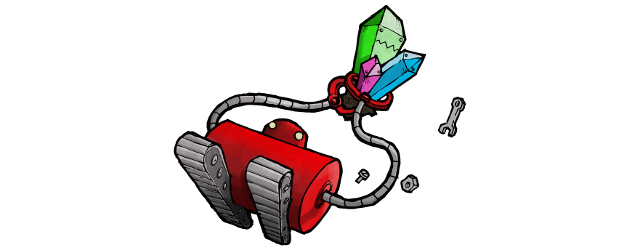
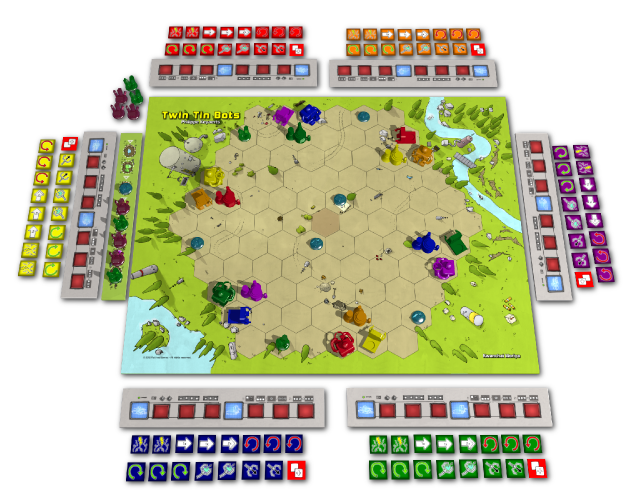
- Game box, 320x220x70 mm.
- Cardboard insert with 4 'pocket' storage spaces in the box
- The rules book
- One two-sided game board (2-4 players, 5-6 players).
- 6 player mats, and a gem track.
- 6 sets of 16 order tiles.
- one set of special order tiles.
- 18 plastic player pieces (6 sets of one base and two robots, in 6 colors)
- 18 clear plastic crystal pieces (3 models in 3 colors, 6 pieces of each)
- 12 ziploc bags, for easy storage of all the bits
- 1 stickers sheet with Left and Right arrows for the robot shoulders.
- (Colored arrows on transparent background)
- Any stretch goals met during the campaign!
All pictures are from a prototype version, not actual game components.
Twin Tin Bots was funded on kickstarter on May 10, 2013. The official release date for the game is 'whenever it is ready'. Our current estimate is Q4 2013.
We wish to thank all backers who helped make Twin Tin Bots a reality, as well as the following shops who pledged to carry the game on its release :
Participating retailers :
- Black Diamond Games (Concord, CA, USA)
- Castle Perilous (Carbondale, IL, USA)
- Myriad Games - Salem (NH, USA)
- Myriad Games - Staten Island (NY, USA)
- Myriad games - Manchester (NH, USA)
- Legion Games - Burnsville (MN, USA)
- Fair Game Store - Downers Grove (IL, USA)
- Gnome Games - Green Bay (WI, USA)
- -
Downloads
